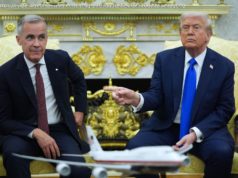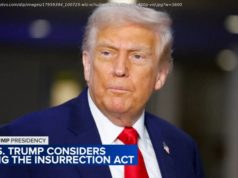There’s no evidence the president wants to create an alternative to the Democratic and Republican parties, and even if he did, he would be remarkably ill-suited to it.
There’s no evidence the president wants to create an alternative to the Democratic and Republican parties, and even if he did, he would be remarkably ill-suited to it.
Congress has raised the debt ceiling dozens of times since the 1960s alone, and the White House has, as far as I can tell, favored the increase every time. Yet only President Trump’s deal with Democratic leaders Nancy Pelosi and Chuck Schumer has inspired pundits to proclaim a wholesale realignment of the political system. The agreement, struck over the objections of Trump’s nominal Republican allies, Speaker Paul Ryan and Senate Majority Leader Mitch McConnell, provides money for disaster relief, funds the government through mid-December, and raises the debt ceiling for the same stretch. It also raises the specter of Trump running as an independent candidate for president or starting a third party that could draw from both Democrats and Republicans. But these fantasies are just that. Presidents often use their own party’s core support as a foil and cut deals with the opposing party. Trump’s quick confederation with Democrats—it’s more of a one-issue stand than a marriage of convenience—is narrowly scoped, and there’s little evidence to suggest Trump has the attention span or political ability to forge a more lasting alliance. Besides, third parties are structurally challenged almost unto impossibility in American politics, and the president’s lack of ideological commitment, while an advantage in some respects, would make it even harder for him to convene one. The manner in which Trump forsook Ryan and McConnell is more interesting than the fact that he did it. For the president to so blithely throw over his own allies, in the midst of a meeting with their Democratic counterparts, after GOP leaders had reportedly received assurances that Trump would do no such thing, only reinforces what an unreliable ally he is. (The lesson is likely not lost on Pelosi and Schumer, even as they take a victory lap on the deal.)
Yet the substance of the deal is less surprising. Since the executive branch has the responsibility of paying the bills Congress has already accrued, it stands to reason that the president would want the authority to pay those debts and to avoid a catastrophic national default. It’s reasonable that he’ d be wary of GOP leaders’ desire to try to extract spending cuts or other wins—especially given Ryan and McConnell’s struggles to marshal their own caucuses so far during Trump’s presidency. Given his own apparent (current) preference for a legislative fix for DACA, it’s also no surprise that Trump wouldn’ t mourn loss of leverage against that. Besides, he’s just not that great a negotiator. But previous presidents have also upset their parties, often by design. Bill Clinton’s “triangulation” necessarily meant bucking Democrats on some matters. George W. Bush’s “compassionate conservatism” was an explicit shot at Republican orthodoxy, and he clashed with the GOP while he was president, from social issues to fiscal ones like Medicare Part D. By 2006, Jonah Goldberg was casting Bush out of conservatism—though, to Goldberg’s credit, not speaking of a third party. (Bush was, of course, term-limited by then, and his tanking popularity made him an unlikely leader of a successful third party.) The last administration felt at times like a long war between Barack Obama and Democrats, occasionally punctuated by fierce outbreaks of amity. Democrats were upset at Obama for giving them less deference and attention than they wanted even before he was elected, and they kept getting upset at him over the course of his term. Often their gripe was that he was giving too much away to the opposition party. In December 2010, they were “slamming” him for giving Republicans an estate-tax exemption. A pre-disgrace Anthony Weiner called that “one of the biggest problems, because that was the one we had the most leverage on.” (Sound familiar?) The next spring, Democrats railed against an Obama deal to keep the government open. “How is it that the House Democrats played such an important role [in the majority] , and all of a sudden [the White House says] , ‘Forget it, we’ ll work with the Senate and the Republican leadership?,’ ” Representative Henry Cuellar complained that summer. By the end of the year, Obama and Senate Majority Leader Harry Reid were sniping at each other, largely because Reid found Obama to be a weak negotiator prone to give away leverage. Matters scarcely improved over the following five years.
Obama promised to change the way Washington worked, but his deals with Republicans did little to actually build a lasting rapport with them, while also angering his own Democratic Party. Trump, who despite manifestly disliking his predecessor sometimes comes across as a bizarro version of Obama, also seems to be threatening to change the way Washington works, showing a willingness to reach across the aisle. Believe it when you see it. Trump truly has fewer ties to his party, either as a matter of political views or in terms of relationships and institutional dependency, but his betrayal of GOP leaders last week is one of the weaker examples of that fact. Even if the Schumer-Pelosi deal were of greater import than simply being a three-month, ad-hoc agreement, and even if a president bucking his own party really were unprecedented, it is simply a fact that it is practically impossible to break the two-party duopoly in contemporary American politics, as Peter Baker wisely notes in his own piece on Trump being untethered from his party. This is particularly true of a centrist third party. Nonetheless, journalists write fan-fiction about a possible third party so frequently that Brendan Nyhan can practically write debunkers in his sleep. Now Matthew Walther imagines that Trump leaving the GOP would, “in a single Death Star-like instant, destroy the illusion that the calcified two-party system accurately represents the views and aspirations of some 300-plus million Americans.” Yet even though Walther pretends that this would destroy the existing two parties, his version of the fantasy requires that most Republicans would still line up behind Trump. The duopoly is dead, long live the duopoly.
A Trumpist third party would presumably espouse some flavor of centrism—or at least would draw from both fiscally non-conservative Republicans and socially conservative Democrats. (This would make it the mirror image of the fiscally conservative, socially liberal party often postulated for that other cranky, aging New York businessman, Michael Bloomberg.) Were Trump to attempt to form a third party today, as opposed to if he had done so after dropping out of the GOP primary in 2016, he would enjoy the unique advantage of the presidency. But in most other ways, he would be especially unsuited to leading a new third party. You can’ t build a Trumpist third party because there’s little evidence a coherent Trumpism exists—his agenda seems more like an agglomeration of white grievance politics and a grab bag of other things that caught Trump’s attention. Walther imagines that leaving the GOP would free Trump to pursue any number of programs that are antithetical to Republican dogma but might attract Democratic voters.






